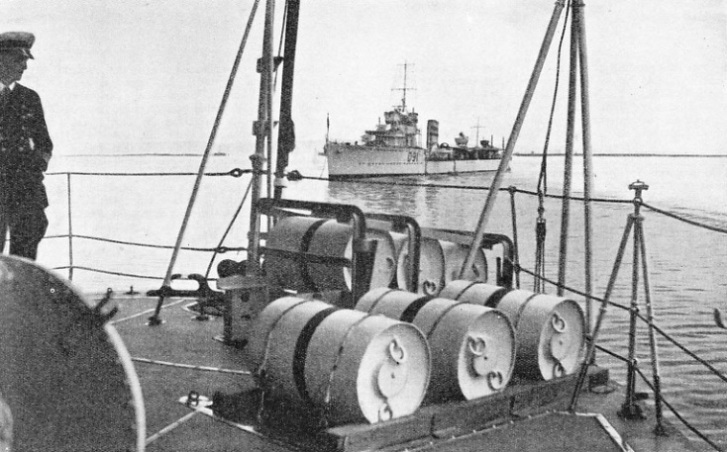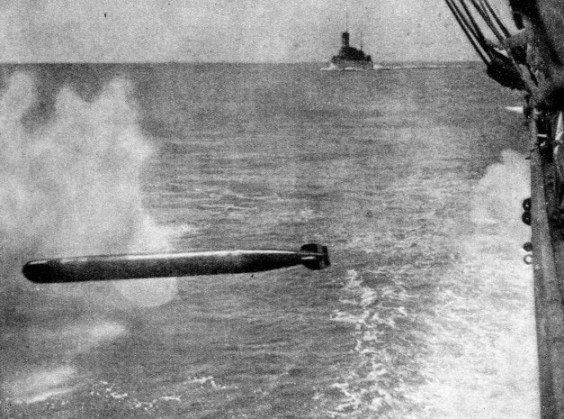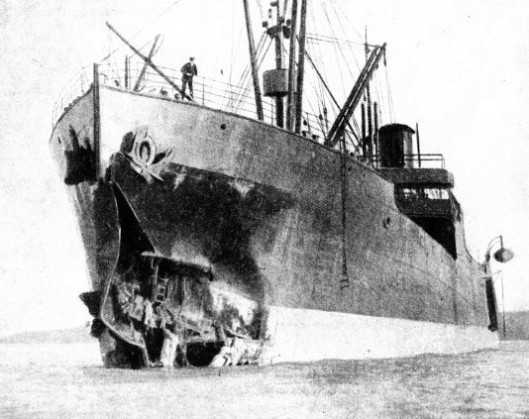

© Shipping Wonders of the World 2012-

Undersea Weapons
Probably the most effective of all methods of attack in naval warfare is the use of weapons such as the torpedo, the mine and the depth charge, which are particularly dangerous because they strike below the water-

DEPTH CHARGES on the deck of HM flotilla leader Kempenfelt. Specially designed for use against submarines, the modern depth charge is a metal cylinder 20 in long and 18 in in diameter. It contains 300 lb of TNT (trinitrotoluene) and will disable a submarine that is caught within 70 feet of the explosion. The Kempenfelt, built in 1933, has a displacement of 1,390 tons, and her geared turbines of 36,000 horse-
THE fact that every combatant ship in the Royal Navy, other than the sloop, is armed with torpedoes is striking evidence of the respect in which this weapon is held. Compared with the gun the torpedo is not, and is never likely to be, an arm of precision. It has been aptly described as “a weapon of opportunity”, in the use of which chance must always play a big part. But when the torpedo does strike home the effect of its blow is, as a rule, far more deadly than that of the heaviest gun projectile. This is because the blow is delivered well below the waterline, rupturing the hull of the ship and admitting the sea.
Unless, therefore, a torpedoed ship is efficiently sub-
The first locomotive torpedo was produced about seventy years ago by the joint efforts of an Austrian naval officer, Captain Luppis, and a British engineer, Robert Whitehead. Having, studied the effects of underwater attack in the American Civil War, during which many vessels were destroyed in this way, Luppis cast about for a method by which an explosive mine could be self-
The original locomotive torpedo was a cigar-
the pressures due to varying depths of water to operate horizontal rudders.
Thus, when the torpedo tries to rise above the horizontal plane at which it is set to run, the rudders automatically force it back to the proper depth. Conversely, if for any reason the torpedo tends to dive below that depth, it is brought back to the true plane by the reflex action of the rudders.
Whitehead’s first torpedo carried in the nose a charge of gunpowder detonated by percussion. When demonstrated before naval experts the new weapon proved a great success, and the Whitehead torpedo was immediately adopted by all important navies. Its principal defect was low speed — only 8 knots — but this was soon remedied by the introduction of the famous Brotherhood three-
Since those far-
The largest torpedo of which the existence has been publicly disclosed is the British 24½-

FIRING A TORPEDO from H.M.S. Cornwall. Modern torpedoes have a diameter of about 21 in. and are charged with about 550 lb. of T.N.T. The monster “ fish” enters the water at a speed of about 50 knots. H.M.S. Cornwall is a cruiser of the Kent class, built in 1928, and has a displacement of 9,750 tons.
The usual method of discharging the torpedo is from a tube of corresponding diameter. The torpedo fits snugly in the tube, along the upper part of which there is a groove engaging a lever fixed to the torpedo. Discharge is effected either by powder or compressed air, and as the torpedo shoots forward the lever is tripped by a catch in the tube and the engines are set in motion. Thus, before the torpedo enters the water its twin propellers are revolving at high speed. The torpedo is first set to run for a certain distance and at a given depth, and once the necessary adjustments have been made the control mechanism does the rest.
Menace to Friend and Foe
In peace-
Destroyers, as well as all modern cruisers, carry deck torpedo tubes which can be trained through a wide arc on either beam. In most battleships, however, the tubes are submerged and fixed, and the ship herself must be manoeuvred to bring the torpedo sights to bear on the target. To fire a torpedo from a submerged tube when the ship is steaming at high speed is not a simple operation. Were the torpedo just shot out of the tube the rush of water along the side would be liable to damage the weapon. To avoid this a steel screen, or “spoon”, of the same length as the torpedo, is thrust out from the side of the ship, parallel with the tube, just before firing. The torpedo is then discharged, and being protected by the “spoon”, it has time to attain speed before meeting the rush of water.
Thanks to the development of torpedo sighting and director appliances, excellent practice is now made even at long range, though war experience proved that with torpedoes fired from surface ships the proportion of hits is low. A submarine has the advantage of being able to approach the target more closely and, as a rule, its presence is not detected up to the moment of firing. For these reasons the percentage of hits made by torpedoes fired from submarines is comparatively high. It would undoubtedly be much higher but for the difficulties inherent in aiming through a periscope.
Two factors which, either separately or jointly, have enabled many a vessel to evade torpedo attack are the upheaval of water caused by discharge from a submerged position and the tell-
The naval mine is a weapon of some antiquity. It took a heavy toll of ships in the American Civil War, and forty years later proved an almost decisive instrument in the Russo-
The modern naval mine is a pear-
Mines may be laid at almost any depth. They are kept at the required distance from the surface by heavy sinkers, to which they are attached by steel cables. Minelaying can be, and has been, performed by every class of vessel, from battleship to submarine.
Efficiency of Paravanes
Unlike the torpedo, the mine gives no warning of its presence unless it becomes detached from its cable by chafing or heavy weather and bobs up to the surface, where it is still a menace unless detected in time.
On the other hand, the explosion of a single mine may reveal the existence of a whole field, as so often happened in 1914-
This device is an adaptation of the fisherman’s “otter”. In shape it resembles a squat torpedo equipped with fixed fins and a rudder actuated by water pressure. It is also fitted with a pair of steel jaws resembling the teeth of a shark. Two paravanes are carried by a ship, to the forefoot of which they are attached by wire cables. As the vessel forges ahead the action of the fins causes the paravane to stream away from the bows at an angle of 50 degrees, while the rudder keeps it at a fixed depth below the surface. Thus the vessel is protected by a V-
Various forms of paravane have been evolved to suit different ships, including a special type which can be towed astern at high speed by destroyers. As far as is known, no ship equipped with paravanes was ever damaged by a mine during the war of 1914-
Last, but not least, among the Navy’s undersea weapons is the depth charge, a type of mine specially designed for anti-

STRUCK BY A TORPEDO “END-
You can read more on “Big Guns in Action”, “Design of the Torpedo”, and “The Ship and the Gun” on this website.